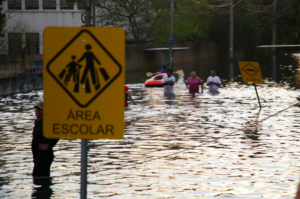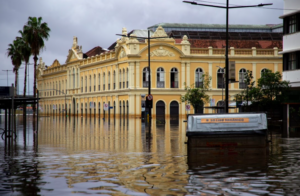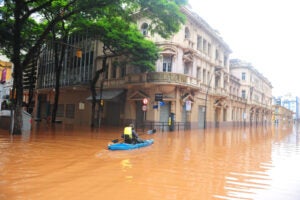The May 2024 floods in the southern Brazilian state of Rio Grande do Sul represented the largest climate disaster in the region's history. Virtually all of the state’s towns were under water, 615,000 people were displaced, and 183 people died. The trail of destruction resulted in drinking water shortages, power outages, and the capital’s airport being closed for five months.
Local media outlets faced challenges keeping the public informed, ranging from the loss of physical infrastructure to operational difficulties in continuing to report events. In response, Reporters Without Borders (RSF) launched the Climate Resilience Project for Journalism in Rio Grande do Sul in January. The initiative is part of a new global RSF directive to incorporate the climate crisis into its mission to defend press freedom and protect journalists under threat.
"Journalism plays an essential role in addressing the climate crisis, as society needs to be well-informed to understand and react to one of the greatest challenges of our time," Artur Romeu, director of RSF's Latin America office, told Latam Journalism Review (LJR). "We are incorporating this agenda into a broader crisis response logic, seeking strategies to enable journalism in extreme scenarios."
A concrete example, Romeu said, was distributing dozens of power banks and charging stations to journalists last year in Ecuador, where power outages and blackouts exceeded 14 hours daily for several months.
RSF will provide financial support to news outlets affected by last year’s heavy rains and floods in Rio Grande du Sol. The recipients have yet to be selected, Romeu said. RSF hired the Digital Journalism Association (Ajor for its initials in Portuguese) to conduct a survey that will guide the selection process, he added. The initiative also aims to foster a discussion on climate resilience in journalism, encouraging newsrooms to better prepare for covering extreme weather events.
"This means journalists working with more appropriate safety protocols and equipment, and also more knowledge about the climate change debate so they can better inform society and mitigate the risks associated with misinformation during crisis periods," Romeu said.

Flooded street in the North Zone of Porto Alegre (Isabela Rieger/Courtesy of Sul 21)
The first phase of the project for Rio Grande do Sul took place in January. Thiago Mattos, RSF’s crisis response and assistance officer for Latin America, told LJR that he met with 11 local media outlets to discuss how their newsrooms were impacted by the floods, identify best practices and outline strategies to strengthen independent and regional media in the face of future crises. The data collected in this initial dialogue will guide concrete actions for equipment provision and training.
"The idea is for this project to be a showcase for similar RSF actions worldwide," Mattos told LJR. "The plan is to distribute emergency kits by the end of the year, with items like rubber boots, waterproof overalls, power stations, and first aid materials. The focus is on smaller and independent newsrooms that cannot acquire these items directly. We are also preparing training sessions."
RSF also aims to develop guidelines to help other journalists in extreme climate situations. According to Mattos, the idea is to produce a manual with general instructions on how to act in different climate disasters, such as extreme winds and heat, similar to manuals already produced by RSF with instructions on what to do in cases of coups or political persecution.
"Even large outlets didn't have a contingency plan at this level,” Mattos said. “RSF has experience in this type of creation, not so much for disasters, but for situations like coups or being a victim of political persecution."
The site Sul21 is one of the independent outlets participating in the RSF project. While large outlets had dozens of professionals and a structure that allowed detailed reporting across the state, staff at Sul21 sought to take a different approach. The team built on previous coverage of local politics, environmental issues, and city projects to produce in-depth, analytical content. They also conducted impactful photographic coverage, significant for an outlet with only one photographer. According to editor Ana Ávila, almost the entire team was affected, having to leave their homes due to rising water, or facing power, water, or internet outages.

Porto Alegre's Public Market, capital of Rio Grande do Sul, during the floods. (Isabela Rieger/Courtesy of Sul 21)
"Work follows a different logic when, on one hand, we need to report what's happening around usand on the other, we need to relocate, seek potable water, ensure our own safety," Ávila told LJR. "We had to take turns based on each person's needs to handle coverage and our personal well-being."
Operating since 2010 and managed since 2020 by its journalists' collective, the outlet celebrates its anniversary in May, the month of the catastrophe and also when they would have conducted a fundraising campaign. However, the small team, at the time composed of 10 people, who work both in fundraising and reporting, was overwhelmed by the tragedy.
"There was neither the atmosphere nor time to do anything other than report what was happening around us,” Ávila said. “Some financial partners also faced economic difficulties, revenue fell, and the impact came in the following months when we faced serious financial challenges. It seems contradictory, but at the moment we were doing one of the most important coverages in our history, we were also facing such a delicate financial situation that it almost prevented us from moving forward."
Since then, Ávila says the team has shrunk to eight people and they've shifted their focus to tackle financial challenges.
“The Climate Resilience Project helps us reflect on what we did that worked and where we were unprepared,” Ávila said.“Regarding journalistic coverage, we realized issues that seem simple but can paralyze coverage, such as the need for power banks or rubber boots."
Founded in Porto Alegre in 1895 and with around 90 newsroom employees, Correio do Povo was also heavily affected by the floods. The building in the center of the state capital, which houses the newsroom and administrative offices, was flooded, as was the newspaper’s printing plant To this day, the print version continues to be produced at another facility through a partnership with Grupo Sinos, a media outlet based in Novo Hamburgo.

The area surrounding the Correio do Povo building under floodwaters. (Fabiano do Amaral/Courtesy of Correio do Povo)
"For us, things will never be the same again. No one was prepared for an event of this magnitude," editor-in-chief Telmo Flor told LJR. "We believe this RSF project can help consolidate procedures and protocols that will assist the entire press in future events, especially regarding the professional stance we must adopt. We never felt we had the right to become victims in a way that would require volunteers or public authorities—those rescuing people—to come save us"
At the height of the crisis, Flor said, nearly everyone worked remotely, with some taking on roles outside their usual duties. One editor went back to reporting, donning boots and a raincoat to cover the story in the field. The political editor took over as general editor, and Flor himself helped put together the front page. He said even the newspaper’s president put on fishing gear to wade into the flooded headquarters and help move computers and equipment to higher floors. He recalled how several colleagues had to flee their homes for higher ground, only to be displaced again when the flooding reached their new locations.
"This was the reality for many of us for a long time. But even those directly affected by the floods contributed to the coverage in some way. One journalist lost his home, relocated to the coast, and still reported from there," said Flor. "I live close to the river, but my house wasn’t flooded—though I was left without water. I was grateful for the warm weather in those first days because we had to fetch cold water from the condo’s swimming pool in buckets just to take a shower."

Inside the Correio do Povo building after the floods (Pedro Dreher/Special/Courtesy of Correio do Povo)
Even with the printing plant underwater, Flor decided to maintain the traditional print format in their coverage by providing readers with a digital PDF version—something they were already familiar with.
"The foundation of a newspaper like this is still the print edition. From the beginning, we decided that we would, of course, cover the story through our website, social media, videos, and other platforms, but we would keep the newspaper format—not just for readers, but also because we discovered that advertisers wanted to maintain their ads," Flor said. "I think we learned, in a moment like this, that we are capable of doing journalism under extreme conditions."